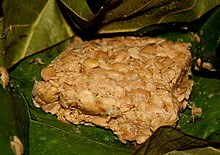Kinema
 | |
| Place of origin | Limbuwan, Sikkim, India, |
|---|---|
| Region or state | Nepal, Bhutan, Sikkim, Darjeeling, Kalimpong |
| Created by | Limbu and Yakkha people |
| Main ingredients | Soybean fermented by Lactobacillus |
Kinema (Nepali: किनेमा) is an indigenous fermented soybean food prepared mostly by the Limbu and Yakkha of the Eastern Himalayan Region what is now Eastern Nepal and Darjeeling, Kalimpong and Sikkim regions of India. [1] The word 'kinema' is believed to be derived from the tribal Limbu language 'kinambaa', where 'ki' means fermented and 'nambaa' It is a traditional food of the Limbu people People .
The slimy, odorous product of fermentation is traditionally prepared into a soup that is consumed with rice, but can also be turned into a savoury dip or a pungent side dish to be consumed along with rice or bread. Kinema is traditionally prepared at home, but now it is sold in local markets and even retailed online as a dried product. Kinema is considered a healthy food because fermentation breaks down complex proteins into easily digestible amino acids. It is very similar to Japanese nattō and akhuni of Northeast India.
See also[]
References[]
- Nepalese cuisine
- Fermented soy-based foods
- Nepalese cuisine stubs